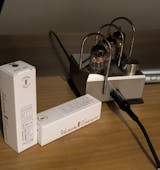
Microphonics of Vacuum Tubes.
Share
Vacuum Tube Microphonics: What to Know and How to Manage It.
We're as passionate about vacuum tubes as you are, and we know how important it is to understand every aspect of them to get the most out of your equipment. Microphonics are a natural characteristic of vacuum tubes and, if properly managed, don't compromise sound quality.
What is Microphonics?
Microphonics is the phenomenon whereby a vacuum tube can convert mechanical vibrations into electrical signals, potentially affecting the sound in some audio systems.
This is a common characteristic of all devices with vibration-sensitive components, including some semiconductors and electronic circuits. In most amplifiers, the level of microphony is negligible and does not affect listening.
How does it manifest itself?
All vacuum tubes, when lightly tapped , can generate an audible sound in the amplifier. However, this phenomenon does not indicate a problem , since microphony is an intrinsic characteristic of their operation.
Our job is to test and select each tube to ensure that microphonics fall within acceptable levels for optimal audio use. Tubes that do not meet these standards are discarded.
One case where microphonics can be more evident is:
- Feedback in Instrument Amplifiers : In guitar or bass amplifiers, the proximity of speakers and tubes can amplify vibrations.
Thanks to our selection process, we only offer tubes that meet the highest quality standards, ensuring an uncompromising audio experience.
Are Newly Produced Valves Immune?
Many customers ask us if newly produced tubes are completely free of microphonics. The reality is that all vacuum tubes exhibit some level of microphonics , regardless of age or manufacturer.
However, modern manufacturing processes can reduce this phenomenon, and we only select tubes that fall within the optimum levels for use in high-quality audio systems.
If you have special needs, such as use in highly sensitive preamplifiers, we can help you choose the most suitable solution.
How Do We Test Valves?
In our shop, each valve undergoes rigorous quality testing to ensure the best possible result.
We use high-precision tools, including:
Amplitrex AT-1000 – to verify electrical performance.
Mac Studio + Audient iD4 – for microphonics and frequency response analysis.


Every signal is analyzed and documented, ensuring that the valves meet our rigorous quality standards.

Tests include:
- Microphonics Testing : Each tube is evaluated under controlled conditions against our internal acceptance criteria, to ensure stable and reliable operation in real-world use.
- Performance Control : Precise measurements to ensure compliance with quality standards.
Each tube is selected to offer the best balance between sound quality and reliability.
How to Reduce Microphonics?
If you want to further minimize microphonics in your system, you can adopt some simple solutions:
-
Tube Dampers : Silicone rings that absorb vibrations.
-
Amplifier placement : Avoid placing it near sources of vibration (e.g. subwoofer).
- Optimized Tube Selection : Some tubes, such as triple mica tubes, are designed to reduce microphonics.
Frequently Asked Questions about Microphonics
-
What is microphonics?
It's the natural behavior of valves to convert vibrations into electrical signals. It's not a defect, but an intrinsic characteristic. -
Do all tubes have microphonics?
Yes, to varying degrees. We test each valve to ensure it falls within acceptable limits. -
Can I reduce the microphonics in my amplifier?
Yes, with accessories such as dampers and with good management of the amplifier positioning.
Our Commitment
At Vacuum Tubes Treasures , we're committed to providing high-quality tubes, individually tested to ensure excellent performance. If you have specific needs, our team is available to help you choose the best solution.
For more information, please contact us via our support page!


